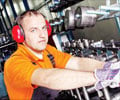The U.S. mass transit system has its benefits - it is one of the safest modes of travel that provides affordable and efficient transportation to over 33 million riders each weekday. The flip side, however, is that according to recent public health studies, it is also linked with some sources of environmental hazards, including excessive noise.
Researchers from the University of Washington and Columbia University have discovered that Metropolitan Transit Authority (MTA) subways have the highest average noise levels of all mass transit in New York City.They even say that these levels are high enough to potentially increase the risk of noise-induced hearing loss, which can be a permanent and irreversible health problem.
Describing their study in the online edition of the American Journal of Public Health, the researchers revealed that they studied the risk of excessive exposure to noise related to mass transit ridership, and conducted an extensive set of noise measurements of New York City mass transit systems.
The research team used sensitive noise dosimeters, and conducted hundreds of measurements of noise levels at platforms and stations. They also measured noise levels inside of vehicles on New York City subways, buses, ferries, commuter railways, and the Roosevelt Island tramway.
They found that, on average, the MTA subways had the highest noise levels, at 80.4 decibels (dBA), followed by the Path trains, at 79.4 dBA, and the tram, at 77.0 dBA.
The lowest average levels measured, 74.9 dBA and 75.1 dBA, were obtained from the LIRR and Metro-North trains, respectively.
Advertisement
According to the researchers, noise levels were generally significantly higher at platforms compared to inside vehicles for all forms of mass transit, except for ferries and the tram.
Advertisement
Dr. Robyn Gershon, an environmental and occupational health scientist and faculty member at the Columbia University Mailman School of Public Health, revealed that subways had the highest noise leves, with roughly half of the maximum levels exceeding 90 dBA.
"At some of the highest noise levels we obtained (ex. 102.1 dBA on the subway platforms), as little as two minutes of exposure per day would be expected to cause hearing loss in some people with frequent ridership, based upon the International Organization for Standardization models for predicting hearing impairment from noise," the researcher said.
Richard Neitzel, of the School of Public Health at the University of Washington, added: "Even though compared to subways, lower levels were obtained for commuter rail, buses, ferries and the tramway, chronic exposure to noise from these other forms of transit could also present a risk of noise induced hearing loss given sufficient exposure duration. The risk rises quickly with even small increases in noise levels. For example, 95 dBA is 10 times more intense than 85 dBA and 100 times more intense than 75 dBA."
Based on their findings, the researchers suggest that noise control efforts, including increased transit infrastructure maintenance and the use of quieter equipment, should be a priority.
They say that the use of personal protection will also be helpful. Music headphones and earbuds generally do little to reduce noise exposures, and in fact often increase exposures, as users turn the volume of MP3 players up even higher than normal to drown out surrounding noise.
The team are currently following up this study with a large, community-based study of noise exposures from multiple sources to develop accurate predictions of noise-induced hearing loss in urban populations.
Source-ANI
TAN










